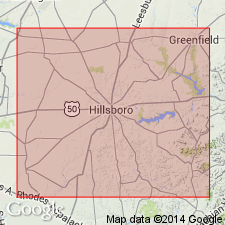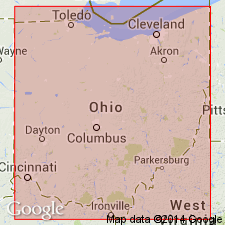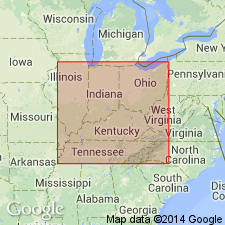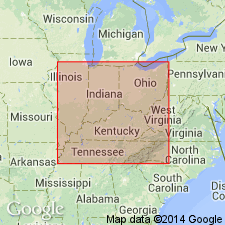
- Usage in publication:
-
- Hillsboro sandstone
- Modifications:
-
- Named
- Dominant lithology:
-
- Sandstone
- AAPG geologic province:
-
- Cincinnati arch
Summary:
[synopsis not included in GNU records (USGS DDS-6; Reston GNULEX).]
Source: GNU records (USGS DDS-6; Reston GNULEX).

- Usage in publication:
-
- Hillsboro sandstone
- Modifications:
-
- Revised
- Age modified
- AAPG geologic province:
-
- Cincinnati arch
Summary:
A restudy of Hillsboro sandstone of Highland Co. has shown that certain exposures formerly interpreted as sandstone layers interbedded in Greenfield and Niagaran dolomites, are really masses of sandstone completely enclosed in the dolomites not more than 30 ft below the Silurian-Devonian disconformity, which here cuts across Greenfield and Niagaran dolomites. The other exposures are of sandstone resting on either the Greenfield or the Niagaran at the horizon of the disconformity. The Hillsboro is interpreted as including two types of deposits of same age: discontinuous sand laid down on the post-Silurian erosion surface and sand washed down into existing cavities beneath this erosion surface. The Hillsboro is younger than the erosion interval which came after the formation of Greenfield dolomite (Late Silurian) and older than Ohio shale (Late Devonian), which in Highland Co., lies next above the Silurian-Devonian disconformity. The Hillsboro is in the same stratigraphic position as Sylvania sandstone (Early Devonian) in northwestern OH.
Source: GNU records (USGS DDS-6; Reston GNULEX).

- Usage in publication:
-
- Hillsboro sandstone
- Modifications:
-
- Overview
- AAPG geologic province:
-
- Cincinnati arch
Summary:
Hillsboro sandstone may represent basal deposits of Lower Devonian and may be of about same age as Sylvania sandstone of northern OH.
Source: GNU records (USGS DDS-6; Reston GNULEX).

- Usage in publication:
-
- Hillsboro sandstone
- Modifications:
-
- Overview
- AAPG geologic province:
-
- Cincinnati arch
Summary:
Unit occurs in two types of deposits: bedded sandstone resting on either Niagaran or Greenfield dolomites and masses of sandstone, which are cavity fillings enclosed in either Niagaran or Greenfield dolomites. Sandstone is white or yellowish frequently stained to reddish brown.
Source: GNU records (USGS DDS-6; Reston GNULEX).

- Usage in publication:
-
- Hillsboro Sandstone [Member]
- Modifications:
-
- Revised
- Age modified
- AAPG geologic province:
-
- Cincinnati arch
Summary:
In this report, Hillsboro appears to be assigned to lower part of Olentangy Shale, but ranks are inconsistent throughout and figures do not clarify relationships. Author states that Hillsboro has previously been incorrectly correlated with Early Devonian Sylvania Sandstone. Here it is correlated with bone bed 14 at the base of the Late Devonian Blocher Member of the Olentangy and paraconformably overlies Late Silurian dolomites.
Source: GNU records (USGS DDS-6; Reston GNULEX).
For more information, please contact Nancy Stamm, Geologic Names Committee Secretary.
Asterisk (*) indicates published by U.S. Geological Survey authors.
"No current usage" (†) implies that a name has been abandoned or has fallen into disuse. Former usage and, if known, replacement name given in parentheses ( ).
Slash (/) indicates name conflicts with nomenclatural guidelines (CSN, 1933; ACSN, 1961, 1970; NACSN, 1983, 2005, 2021). May be explained within brackets ([ ]).

